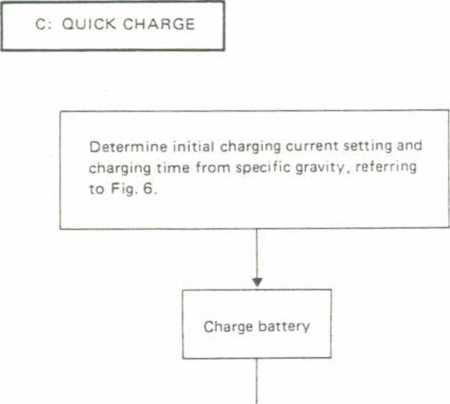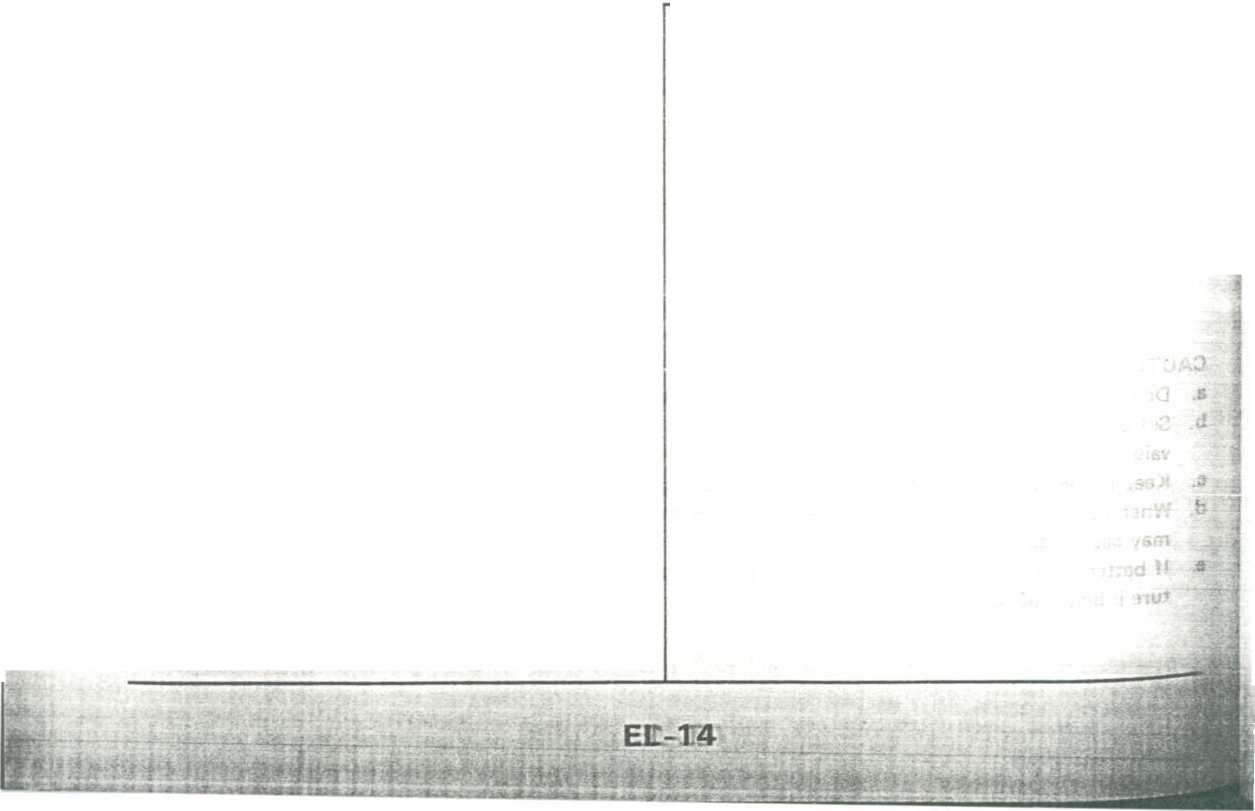349
BATTERY
M.F. Battery Test and Charging Chart (Cont'd)

▼
Go to "CAPACITY TEST".
Fig 6 INITIAL CHARGING CURRENT SETTING AND CHARGING TIME (Quick charge)
|
BATTERY TYPE \ CUR- \ CON- \rent \ VERTED \jAl \ SPECIFIC \ GRAYITY \ |
28B19RIL) MF 34B19RIL) MF |
U. U. u. 5 5 5 j j J cr cr cc <7 £ CN (N CN CD CO O to to o T lO lO |
u. u. u. 522 J J j cr i i n to to M fN CN O O O ifl O to to co |
UL U. 5 5 -j -J 5 cr n ćń O Q to S) O | |
|
10 (A) |
15 IA) |
20 (Al |
30 (A) | ||
|
1 too |
1 130 |
2.5 hours | |||
|
1.130 - |
1 160 |
2.0 hours | |||
|
1 160 - |
1.190 |
1.5 hours | |||
|
1 190 |
1.220 |
1.0 hours | |||
|
Above 1.220 |
0.75 hours (45 min.) | ||||
• Check Battery type and determine the specified current using the table shown above.
• After starting charging, adjustment of charging current is not necessary.
Service'Data and Specifications_
(S.D.S.)

CAUTION:
a. Do not use quick charge method on a battery whose specific gravity is less than 1.100.
b. Set initial charging current to value specified in Fig. 6. If charger is not capable of producing specified current value, set its charging current as close to that value as possible.
c. Keep battery away from open flame whiie it is being charged.
d. When connecting charger, connect leads first, then turn on charger. Do not tum on charger first, as this may cause a spark.
e. Be careful of a rise in battery temperaturę because a large current flow is required during quick-charge operation.
!f battery temperaturę rises above 60“ C (140° F), stop charging. Always charge battery when its temperaturę is below 60°C (140° F).
f. Do not exceed the charging time specified in Fig. 6, because charging battery over the charging time can cause deterioration of the battery.
|
Applied model |
Ali | ||
|
46B24LMF | |||
|
Type |
Maintenance-free | ||
|
Capacity |
V-AH |
12-45 | |
Wyszukiwarka
Podobne podstrony:
BATTERY.M.F. Battery Test and Charging Chart (Cont d) Chart II-a CAPACITY TEST M.G. • Check battery
iBATTERYM.F. Battery Test and Charging Chart (Cont d) A: SLOW CHARGE Fig. 2 INITIAL CHARGING CURRENT
BATTERYM.F. Battery Test and Charging Chart (Cont d) Fig. 4 INITIAL CHARGING CURRENT SETTING (Standa
H They ’re sexy, They*re single. And tkeyfre Southern! They’re*„ Early this year, Temptation is
zg4719�1 C=D cs) « System and Sec... ► Windows Update ▼ Search Control Panel p Most recent che
zh5943�8a CD v « System and Security ► Windows Update ▼ Search Control Panel p Most recent
result Download the free IMDb Android appFind Movies, TV shows, Celebrities and morę... Ali Movie
tq2287�6
MANUAŁ STEERING GEAR AND LINKAGE — R22TDiassembly (Cont d)__Inspection_ RACK 1. Remove tie-rod inner
INTERIOR AND EXTERIOR_Interior (Cont d)ROOF TRIM INSTALLATION Affix double-faced adhesive tape to bo
INTERIOR AND EXTERIOR-Exterior (Cont d)_ ts. F280Dd. :809A nark gap 13 P strip 168B 4; Roof
INTERIOR AND EXTERIOR_Exterior (Cont d)_ @ Cowl top sealing rubber (Q), @ Hood front sealing rubber
2. Measure toe-in. FrontCHASSIS AND BODY MAINTENANCE _Checking Wheel Alignment (Cont d)_ Lines paral
SERVICE DATA AND SPECIFICATIONS (S.D.S.)-Chassis and Body Maintenance--(Cont d) TIGHTEIMING
POP ~ CHART LAB „ FREE STANDARD SHIPPING Oh PRINTS HOUSEWARES STATIONERY WALL DECOR30 CLASSIC P
więcej podobnych podstron